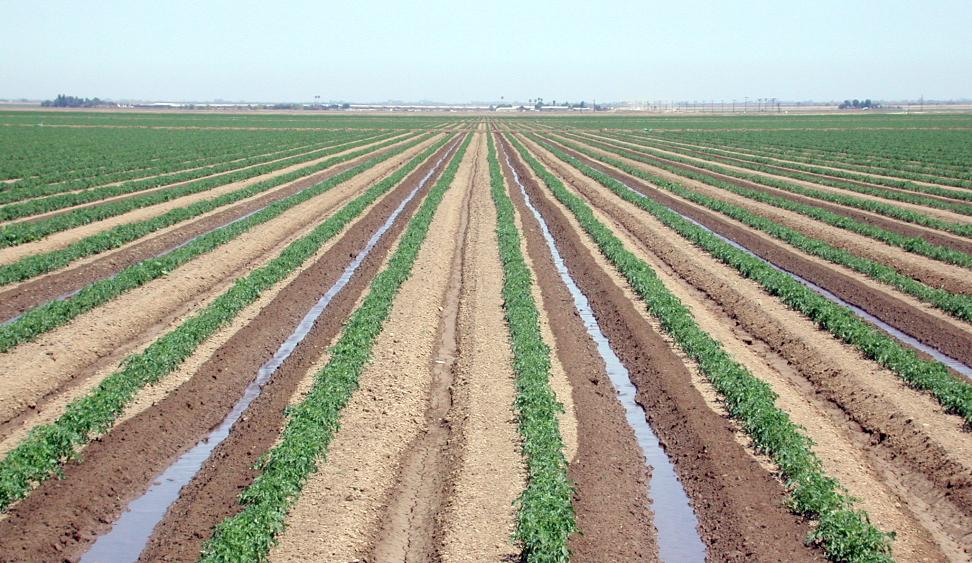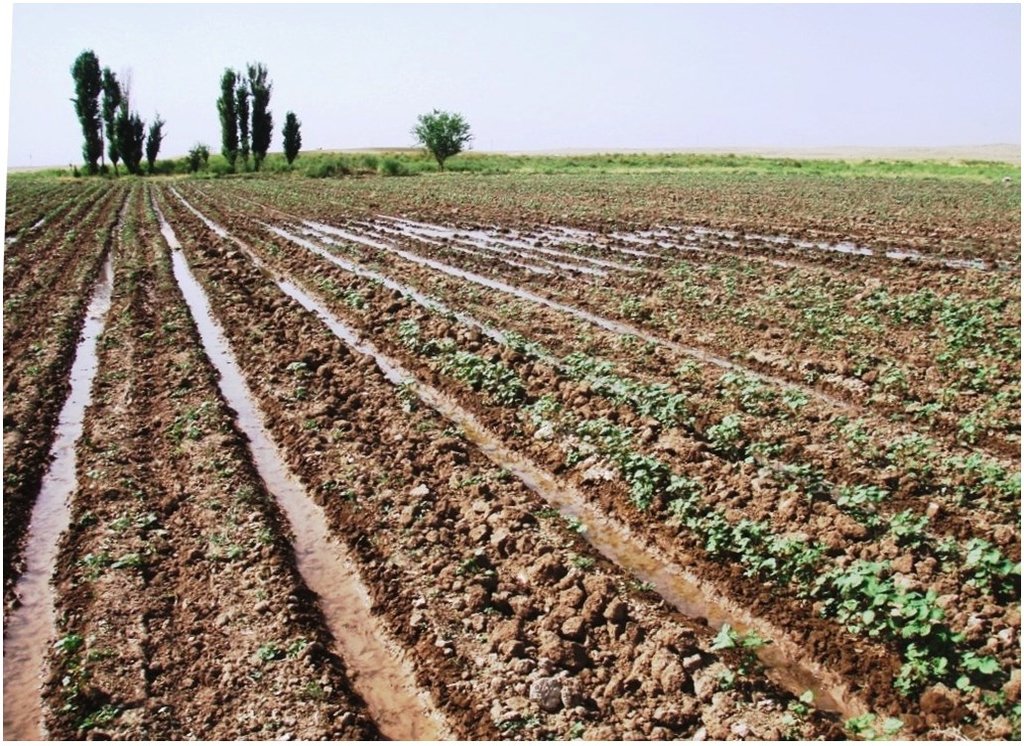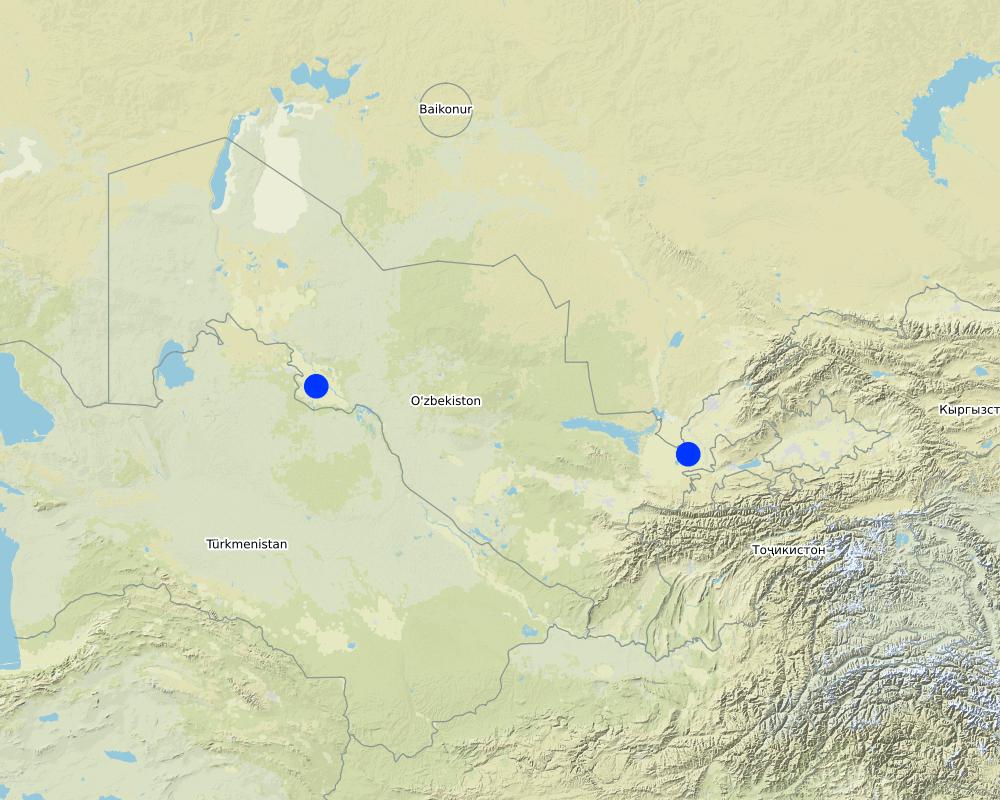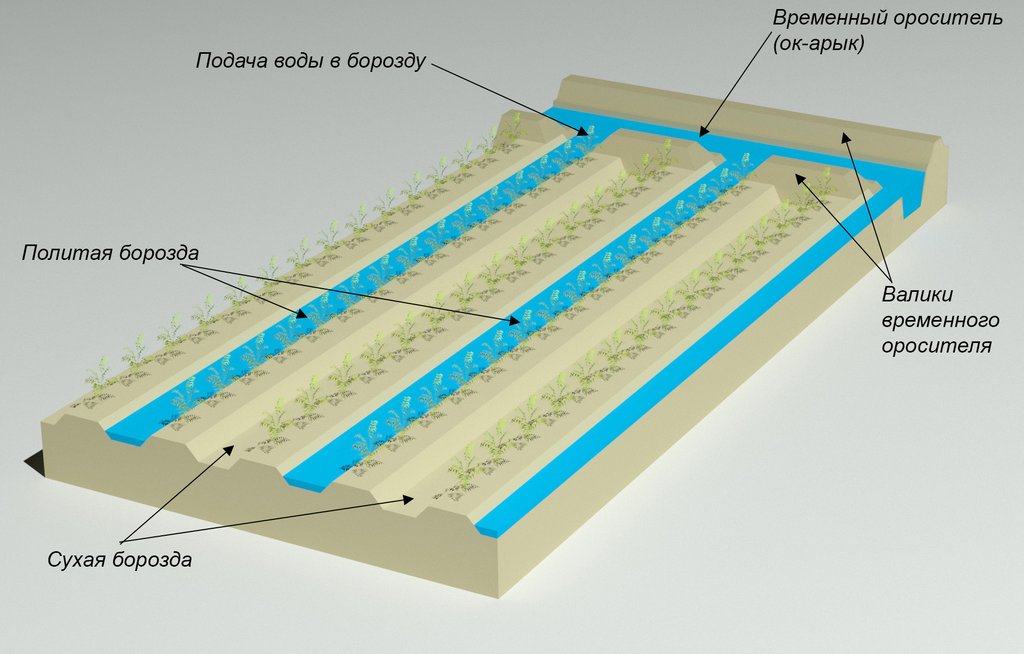Furrow irrigation with alternating dry and watered (wet) furrows [Uzbekistan]
- Creation:
- Update:
- Compiler: Rustam Ibragimov
- Editor: –
- Reviewers: Alexandra Gavilano, Olga Andreeva, Elizaveta Soloveyva
Furrow irrigation with alternating dry and watered (wet) furrows
technologies_3646 - Uzbekistan
View sections
Expand all Collapse all1. General information
1.2 Contact details of resource persons and institutions involved in the assessment and documentation of the Technology
Key resource person(s)
SLM specialist:
Paluasheva Gauhari, Kalbaevna
Central Asian Research Institute of Irrigation
Uzbekistan
Shirokova Julia, Illarionovna
Central Asian Research Institute of Irrigation
Uzbekistan
Name of project which facilitated the documentation/ evaluation of the Technology (if relevant)
Decision Support for Mainstreaming and Scaling out Sustainable Land Management (GEF-FAO / DS-SLM)1.3 Conditions regarding the use of data documented through WOCAT
The compiler and key resource person(s) accept the conditions regarding the use of data documented through WOCAT:
Yes
1.4 Declaration on sustainability of the described Technology
Is the Technology described here problematic with regard to land degradation, so that it cannot be declared a sustainable land management technology?
No
2. Description of the SLM Technology
2.1 Short description of the Technology
Definition of the Technology:
To prevent large crop losses, it is recommended to water row crops through the furrow. Dry and watered furrows are rotated. Watering is carried out during periods of lack of water (low water).
2.2 Detailed description of the Technology
Description:
Irrigated agriculture is the basis of agricultural production in Uzbekistan. However, water scarcity is a limiting factor, especially in dry years. Watering through the furrow is a technological method used by farmers in conditions of limited water supply. This allows to reduce the duration of irrigation by 1.3 - 2.4 times. The water demand for irrigation and the total water consumption (evaporation and transpiration) is reduced by 20-25%. Due to the technology, the cotton bushes are short with a well-developed root system. Monitoring of soil moisture using sensors showed that soil moisture at a depth of 40 cm in dry (not flooded) and wet (flooded) furrows is almost the same at the beginning of the second irrigation.
Consequently, in conditions of close groundwater table, it is better to start irrigation through the furrow not from the first irrigation, but from the second irrigation. This will minimize the possible crop damage because of the lack of soil moisture. The soil moisture equitability (and salt background) can be ensured by the rotation of irrigated and non-irrigated furrows at each subsequent irrigation. It is recommended to rotate flooded and dry furrows from watering to watering (even - 1 watering, odd - second watering, etc.).
Esteblishment activities and costs of inputs
Activities and contributions to the introduction / content: The practice of preparing the field is common, as with the farmer. On the plot of irrigated land under sowing of cotton (farm field), furrows are cut 100 m long, irrigation through the furrow is carried out by supplying more than usual water consumption
1. Land preparation: site levelling, plowing, salinization flushing
2. Channel development
3. Furrow irrigation
4. Agro-technological operations.
5. Flushing after cotton vegetation
2.3 Photos of the Technology
2.5 Country/ region/ locations where the Technology has been applied and which are covered by this assessment
Country:
Uzbekistan
Region/ State/ Province:
Khiva district, Khorezm region; Mirzaabad district, Syrdarya region
Specify the spread of the Technology:
- evenly spread over an area
If precise area is not known, indicate approximate area covered:
- < 0.1 km2 (10 ha)
Comments:
Materials collected from various sources Central Asian Irrigation Research Institute / CEF Project 2006; NIIIVP / JIRCAS 2015, 2016, (Syrdarya region, Mirzaabad district), graduate student G. Paluashova, OPKh Central Asian Research Institute of Irrigation
Map
×2.6 Date of implementation
If precise year is not known, indicate approximate date:
- 10-50 years ago
2.7 Introduction of the Technology
Specify how the Technology was introduced:
- during experiments/ research
- through projects/ external interventions
3. Classification of the SLM Technology
3.1 Main purpose(s) of the Technology
- improve production
- Reducing water costs for irrigation and preventing crop losses within a lack of water is the main task
3.2 Current land use type(s) where the Technology is applied

Cropland
- Annual cropping
Number of growing seasons per year:
- 1
Specify:
The growing season allows to get only 1 crop per year of the main crops - cotton and wheat. It is possible to get a second crop if to plant a crop with a short growing season (legumes, potatoes and melons) after harvesting wheat
3.4 Water supply
Water supply for the land on which the Technology is applied:
- full irrigation
3.5 SLM group to which the Technology belongs
- irrigation management (incl. water supply, drainage)
3.6 SLM measures comprising the Technology

agronomic measures
- A7: Others
Comments:
Other: Adaptation to the lack of irrigation water by improving the furrow irrigation method
3.7 Main types of land degradation addressed by the Technology

chemical soil deterioration
- Cn: fertility decline and reduced organic matter content (not caused by erosion)

other
Comments:
Less leaching of nutrients from the soil by irrigation water. Secondary salinization is caused by natural conditions (arid climate, difficult conditions for soil outflow) and anthropogenic activities (inefficient use of irrigation and drainage infrastructure, non-compliance with irrigation standards). The decrease in humus content is the result of disturbances in agricultural technology (low standards of organic fertilizers, harvesting of plant residues from the fields). Soil compaction is caused by plowing the soil with a dump plow at the same depth (the formation of a “sub-sole”). Colmatation of soil pores by suspended particles of irrigation water contributed to the reduction of porosity, water permeability, air capacity of the soil. Biological degradation is caused by the deterioration of the habitat of soil organisms due to salinization and low humus content.
3.8 Prevention, reduction, or restoration of land degradation
Specify the goal of the Technology with regard to land degradation:
- reduce land degradation
Comments:
The Technology provides a reduction in nutrient removal during irrigation, reduces the total evaporation from irrigation fields as a result of irrigation through a furrow
4. Technical specifications, implementation activities, inputs, and costs
4.1 Technical drawing of the Technology
Technical specifications (related to technical drawing):
From left to right: Dry furrow - Watered (wet) furrow - Furrow water supply - Temporary sprinkler - Temporary sprinkler mound
Author:
Shirokova
Date:
19/11/2017
4.2 General information regarding the calculation of inputs and costs
Specify how costs and inputs were calculated:
- per Technology area
Indicate size and area unit:
1 ha
Specify currency used for cost calculations:
- USD
If relevant, indicate exchange rate from USD to local currency (e.g. 1 USD = 79.9 Brazilian Real): 1 USD =:
4150.0
Indicate average wage cost of hired labour per day:
about 10 USD
4.3 Establishment activities
| Activity | Timing (season) | |
|---|---|---|
| 1. | Land preparation: site levelling, plowing | Autumn |
| 2. | Flushing | February - March |
| 3. | Preparing for sowing and cotton sowing | April |
| 4. | Channel development | May - June |
| 5. | Furrow irrigation and agrotechnological plant care operations | June - August |
Comments:
Cotton cultivation is carried out according to traditional technology, as in the usual practice of the farmer
4.4 Costs and inputs needed for establishment
| Specify input | Unit | Quantity | Costs per Unit | Total costs per input | % of costs borne by land users | |
|---|---|---|---|---|---|---|
| Labour | Labor costs | USD/ha | 1.0 | 10.0 | 10.0 | 100.0 |
| Equipment | Mechanization costs (levelling, channel development) | USD | 1.0 | 249.4 | 249.4 | 100.0 |
| Other | The acquisition of Weir (Thomson) | USD | 4.0 | 1.2 | 4.8 | |
| Total costs for establishment of the Technology | 264.2 | |||||
| Total costs for establishment of the Technology in USD | 0.06 | |||||
If land user bore less than 100% of costs, indicate who covered the remaining costs:
paid by the Project
4.5 Maintenance/ recurrent activities
| Activity | Timing/ frequency | |
|---|---|---|
| 1. | Land preparation: site levelling, plowing | Autumn |
| 2. | Flushing | February-March |
| 3. | Preparing for sowing and cotton sowing | April |
| 4. | Channel development | May-June |
| 5. | Furrow irrigation and agrotechnological plant care operations | June - August |
4.6 Costs and inputs needed for maintenance/ recurrent activities (per year)
| Specify input | Unit | Quantity | Costs per Unit | Total costs per input | % of costs borne by land users | |
|---|---|---|---|---|---|---|
| Labour | Labor costs | USD/ha | 1.0 | 10.0 | 10.0 | 100.0 |
| Equipment | Mechanization costs (levelling, channel development) | USD/ha | 1.0 | 249.4 | 249.4 | 100.0 |
| Total costs for maintenance of the Technology | 259.4 | |||||
| Total costs for maintenance of the Technology in USD | 0.06 | |||||
If you are unable to break down the costs in the table above, give an estimation of the total costs of maintaining the Technology:
259.4
4.7 Most important factors affecting the costs
Describe the most determinate factors affecting the costs:
The Technology does not require additional imputs. Propaganda and awareness raising are needed to scale up the Technology
5. Natural and human environment
5.1 Climate
Annual rainfall
- < 250 mm
- 251-500 mm
- 501-750 mm
- 751-1,000 mm
- 1,001-1,500 mm
- 1,501-2,000 mm
- 2,001-3,000 mm
- 3,001-4,000 mm
- > 4,000 mm
Specifications/ comments on rainfall:
90-100 mm / year (Khorezm), 324 mm / year (Syrdarya), 90% of precipitation falls in October-May
Indicate the name of the reference meteorological station considered:
Urgench, Syr Darya
Agro-climatic zone
- semi-arid
- arid
The duration of the growing season is 160 days
5.2 Topography
Slopes on average:
- flat (0-2%)
- gentle (3-5%)
- moderate (6-10%)
- rolling (11-15%)
- hilly (16-30%)
- steep (31-60%)
- very steep (>60%)
Landforms:
- plateau/plains
- ridges
- mountain slopes
- hill slopes
- footslopes
- valley floors
Altitudinal zone:
- 0-100 m a.s.l.
- 101-500 m a.s.l.
- 501-1,000 m a.s.l.
- 1,001-1,500 m a.s.l.
- 1,501-2,000 m a.s.l.
- 2,001-2,500 m a.s.l.
- 2,501-3,000 m a.s.l.
- 3,001-4,000 m a.s.l.
- > 4,000 m a.s.l.
Comments and further specifications on topography:
105-120 m (Khorezm) and 273 m (Syrdarya, Gulistan) above sea level
5.3 Soils
Soil depth on average:
- very shallow (0-20 cm)
- shallow (21-50 cm)
- moderately deep (51-80 cm)
- deep (81-120 cm)
- very deep (> 120 cm)
Soil texture (topsoil):
- medium (loamy, silty)
Soil texture (> 20 cm below surface):
- medium (loamy, silty)
Topsoil organic matter:
- low (<1%)
If available, attach full soil description or specify the available information, e.g. soil type, soil PH/ acidity, Cation Exchange Capacity, nitrogen, salinity etc.
Meadow soils, humus content in the arable layer is less than 1%. The volume density (g / cm3) is 1.52 and 1.45-1.51 g / cm3 (Syrdarya region), field water capacity (% by weight) is 20.3-21.9% (Khorezm region) and 25.0-28.0 (Syrdarya region)
5.4 Water availability and quality
Ground water table:
< 5 m
Availability of surface water:
good
Water quality (untreated):
good drinking water
Is water salinity a problem?
Yes
Specify:
Water suitable for irrigation
Is flooding of the area occurring?
No
Comments and further specifications on water quality and quantity:
Water in surface sources is polluted from discharges of drainage from irrigation fields
5.5 Biodiversity
Species diversity:
- medium
Habitat diversity:
- medium
Comments and further specifications on biodiversity:
Vegetation is represented by cultivated plant species: cotton, wheat, vegetables, melons, perennial plantings of fruit and ornamental trees and shrubs
5.6 Characteristics of land users applying the Technology
Sedentary or nomadic:
- Sedentary
Market orientation of production system:
- mixed (subsistence/ commercial)
Off-farm income:
- > 50% of all income
Relative level of wealth:
- average
Individuals or groups:
- individual/ household
Level of mechanization:
- mechanized/ motorized
Gender:
- men
Age of land users:
- middle-aged
5.7 Average area of land used by land users applying the Technology
- < 0.5 ha
- 0.5-1 ha
- 1-2 ha
- 2-5 ha
- 5-15 ha
- 15-50 ha
- 50-100 ha
- 100-500 ha
- 500-1,000 ha
- 1,000-10,000 ha
- > 10,000 ha
Is this considered small-, medium- or large-scale (referring to local context)?
- medium-scale
Comments:
The average size of farms is 35-75 hectares, dekhkan and household plots - up to 0.35 hectares
5.8 Land ownership, land use rights, and water use rights
Land ownership:
- state
Land use rights:
- leased
Water use rights:
- open access (unorganized)
5.9 Access to services and infrastructure
health:
- poor
- moderate
- good
education:
- poor
- moderate
- good
technical assistance:
- poor
- moderate
- good
employment (e.g. off-farm):
- poor
- moderate
- good
markets:
- poor
- moderate
- good
energy:
- poor
- moderate
- good
roads and transport:
- poor
- moderate
- good
drinking water and sanitation:
- poor
- moderate
- good
financial services:
- poor
- moderate
- good
6. Impacts and concluding statements
6.1 On-site impacts the Technology has shown
Socio-economic impacts
Water availability and quality
demand for irrigation water
6.2 Off-site impacts the Technology has shown
impact of greenhouse gases
Specify assessment of off-site impacts (measurements):
The Technology does not have negative off-site impact
6.3 Exposure and sensitivity of the Technology to gradual climate change and climate-related extremes/ disasters (as perceived by land users)
Gradual climate change
Gradual climate change
| Season | increase or decrease | How does the Technology cope with it? | |
|---|---|---|---|
| seasonal temperature | summer | increase | well |
| annual rainfall | decrease | well | |
| seasonal rainfall | spring | decrease | well |
| seasonal rainfall | summer | decrease | well |
6.4 Cost-benefit analysis
How do the benefits compare with the establishment costs (from land users’ perspective)?
Short-term returns:
neutral/ balanced
Long-term returns:
neutral/ balanced
How do the benefits compare with the maintenance/ recurrent costs (from land users' perspective)?
Short-term returns:
neutral/ balanced
Long-term returns:
neutral/ balanced
Comments:
The Technology does not require additional costs for implementation and maintenance. It prevents possible losses due to lack of water. It was shown In experiments conducted in the Khorezm region: reducing the cost of irrigation water up to 33% is achieved, in the Syr Darya region: reducing the cost of irrigation water up to 50% is achieved
6.5 Adoption of the Technology
- 11-50%
Of all those who have adopted the Technology, how many did so spontaneously, i.e. without receiving any material incentives/ payments?
- 11-50%
6.6 Adaptation
Has the Technology been modified recently to adapt to changing conditions?
No
6.7 Strengths/ advantages/ opportunities of the Technology
| Strengths/ advantages/ opportunities in the land user’s view |
|---|
| The Technology does not require additional costs |
| The Technology is easy to implement |
| The Technology reduces the need for irrigation water |
| Strengths/ advantages/ opportunities in the compiler’s or other key resource person’s view |
|---|
| The Technology is easy to implement and accessible to all land users |
| The Technology avoids crop losses during periods of water scarcity |
| The Technology reduces nutrient removal from irrigation water during irrigation |
6.8 Weaknesses/ disadvantages/ risks of the Technology and ways of overcoming them
| Weaknesses/ disadvantages/ risks in the land user’s view | How can they be overcome? |
|---|---|
| Land users did not note any weaknesses |
| Weaknesses/ disadvantages/ risks in the compiler’s or other key resource person’s view | How can they be overcome? |
|---|---|
| There is a risk of secondary salinization on saline soils | Strictly adhere to the recommended irrigation regime |
7. References and links
7.1 Methods/ sources of information
- interviews with SLM specialists/ experts
5 persons
- compilation from reports and other existing documentation
When were the data compiled (in the field)?
20/11/2017
7.2 References to available publications
Title, author, year, ISBN:
"Water conservation on the field - a measure to solve global problems of providing water resources", Shirokova Yu.I., Paluashova G.K.
Available from where? Costs?
Materials of the Republican scientific-practical conference of the Central Asian Scientific Research Institute of Irrigation "Actual problems of water management and land reclamation of irrigated lands" December 12, 2011 Tashkent. S. 196-201
Title, author, year, ISBN:
Water saving effect of the simplified surge flow and alternate dry furrow methods in Uzbekistan. Junya Onishi, Paluashova Ghavharay, Hiroshi Ikeura.
Available from where? Costs?
The 12 –th Conference of International Society of Paddy and Water Environment Engineering «Agricultural water and rural environment for the future» 30 October-1 November 2013. Cheongju, KOREA, 2013. С. 31-42.
Title, author, year, ISBN:
Water saving on the field during irrigation through the furrow in the saline lands of Khorezm. 3.Paluashova G. Shirokova Yu.I.
Available from where? Costs?
The journal "Bulletin of the Agrarian Science of Uzbekistan", No. 2 (56) 2014. P. 30-34.
Title, author, year, ISBN:
The study of the effectiveness of irrigation of cotton through the furrow in saline soils. Paluashova G.K., Shirokova Yu.I., Zhuniya O.
Available from where? Costs?
The journal "Irrigation and Land Reclamation" No. 02 (4). 2016.S. 9-13. (Uzbekistan)
Title, author, year, ISBN:
Water conservation on the field - analysis of opportunities. Shirokova Yu.I., Paluashova G.K.
Available from where? Costs?
Reports of the II International Scientific and Practical Conference “Scientific Support as a Factor of Sustainable Development of Water Resources” June 24, 2016 Taraz. S. 479-484. (Kazakhstan)
Title, author, year, ISBN:
Features of irrigation of cotton through the furrow in saline soils of Uzbekistan. 6.Paluashova G.K., Onishi J., Shirokova Yu.I.
Available from where? Costs?
The path of science. International Scientific Journal, No. 5 (39), 2017, ISSN 2311-2158. The Way of Science. 2017. No. 5 (39). S.35-37. (Moscow, Russia).
Links and modules
Expand all Collapse allLinks
No links
Modules
No modules






